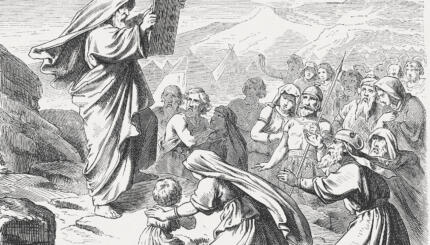Reprinted with the author’s permission from Jewish Law: History, Sources, Principles (Jewish Publication Society).
It is hardly surprising that a man such as Maimonides, whose work superbly reflects systematic organization, would make clear, both to himself and to his readers, his motives and objectives in writing his masterpiece. He did so in detail in the Introduction to his Sefer ha-Mizvot [Book of the Commandments], in the Introduction to his Mishneh Torah, and in several responsa and epistles that he wrote to those who sought his guidance or took issue with him.
Maimonides set forth as the background and motivation for his work the familiar reasons that led in all periods to the writing of compendious but concise codes, namely, the vastness of the halakhic material, the difficulty of understanding the sources and of finding one’s way in them, and the social and historical milieu:
"At the present time, when dire calamities keep following one another and the needs of the moment brush aside all things, our wise men have lost their wisdom, and the understanding of our astute people is hidden. Hence, the commentaries, the codes of law, and the responsa that were written by the geonim, who strove to make them easily intelligible, have presented difficulties in our days, so that only a few are capable of understanding them properly. Needless to say, this applies to the Talmud itself (the Babylonian as well as the Jerusalem), the Sifra, the Sifrei, and the Tosefta — works that require wide knowledge, a learned mind, and ample time before one can discern from them the correct practice as to what is prohibited or permitted, and the other laws of the Torah.
With your help, My Jewish Learning can provide endless opportunities for learning, connection and discovery.
Therefore, I, Moses ben Maimon, the Sephardi, bestirred myself and, relying upon the Creator, blessed be He, have made a thorough study of all these books, and have determined to compose a work containing the results derived from all these books concerning what is prohibited or permitted, unclean or clean, as well as the other laws of the Torah."
Similarity to all Legal Codes
One of the goals Maimonides hoped his code would achieve was to make "all the laws — the rules of each and every commandment, and of all the enactments promulgated by the sages and prophets — clear and manifest to young and old." This aspiration, of course, is similar to that of all codifiers of any legal system.
One Grand and Bold Claim
The background and purpose of the Mishneh Torah described to this point were not particularly novel; similar motives and aims had led to the composition of books of halakhot in earlier periods. The great innovation of Maimonides involved an additional revolutionary objective for the Mishneh Torah–a completely new approach as well as a novel form for setting forth the authoritative distillation of the halakhah. Maimonides, as usual, expressed this grand and bold objective clearly and without equivocation:
"In brief, a person will not need to have recourse to any other work to ascertain any of the laws of Israel. This work is intended as a compendium of the entire Oral Law, including the enactments, customs, and decrees instituted from the days of Moses, our teacher, until the redaction of the Talmud, as expounded for us by the geonim in all the works composed by them since the completion of the Talmud.
Hence, I have entitled this work Mishneh Torah [Recapitulation of Torah], for the reason that a person who first reads the Torah and then this work will know from it all of the Oral Law, and there will be no need to read any other book [written] between them."
As previously stated, Maimonides did not mean by this statement that his code was to be the authoritative legal source of Jewish law. The very introduction to Mishneh Torah, in which the statement just quoted was made, opens with a description of the "chain of the tradition." It specifies the names of all those who were links in the chain, commencing with the Revelation at Sinai–the seminal event and the source of authority for the Jewish legal system. Indeed, it makes clear that everything set forth in the Written Law and in the Oral Law as handed down in the Talmud "is binding on all Israel."
Consequently, all the prior halakhic literature would remain as material for study and analysis, and as a source for legal pronouncements on new problems arising in the future; but finding and ascertaining the halakhah as crystallized up to Maimonides’ time was to be done exclusively by means of his code, for he was fully confident that his code included the entire Oral Law and that there could be no inconsistency between it and the binding halakhic literature up to that time.
Four Basic Objectives
The Introductions to his various works and his responsa indicate that Maimonides set for himself four basic objectives in the preparation and composition of the Mishneh Torah, similar to the guidelines used even today for any type of code in every legal system.
Maimonides’ objectives were:
1. To compile the entire corpus of Jewish law from the Torah up to his own day and to rework this material scientifically and systematically.
2. To select and arrange the material topically.
3. To set forth the law categorically and prescriptively, without associating it with particular sages, without mentioning conflicting opinions, and without source references.
4. To achieve a polished literary style that clearly and succinctly expresses the content of the concepts expounded.
Fulfilling these objectives in codifying the law of any legal system calls for superior skills; fulfilling them in codifying halakhah calls for genius of the highest order.
The Problem of Codifying Jewish Law
Maimonides attained his first two objectives through his extraordinary ability to assemble, rework, and classify material. His third objective was attained in consequence of two characteristics to be expected in someone of his stature–a capacity for boldness, and a readiness to pioneer beyond the conventional.
As has been seen, the codification of Jewish law involves a fundamental problem: Can the Jewish legal system, which is, by its very nature, a continuous chain of tradition harking back to the Torah, tolerate a code containing only a definitive and categorical statement of each law, with no citation of differing opinions and without source references?
Maimonides’ New Genre
The codificatory literature reviewed to this point has shown that until the time of Maimonides no work had been written that briefly set forth the laws without stating the names of those by whom the laws were transmitted or the talmudic sources of the laws.
In Maimonides’ view, this tended to make it more difficult to arrive at a legal conclusion and made the existing codes difficult to understand and of limited utility. He therefore created a new genre of codificatory literature–a systematic halakhic work presenting legal rules categorically in prescriptive form, with no reference to sources or contrary opinions. Maimonides explained his method and motives:
"I decided to put together the results obtained from all those [previous] works, as to what is forbidden or permitted, [ritually] pure or impure, together with the other laws of the Torah, all in plain and concise language. Thus, the entire Oral Law, systematically arranged, will become familiar to all, without citing arguments and counterarguments — one person saying one thing and another something else.
Rather, [the law will be stated] clearly, pointedly, and accurately, in accordance with the conclusions drawn from all these compilations and commentaries that have appeared since the time of Moses to the present, so that all the laws, whether [biblical] precepts or enactments adopted by the sages and prophets, will be accessible to old and young alike."
Opposition to Maimonides’ Method
Maimonides’ code was faithful to this approach, nearly always stating the law categorically, prescriptively, and without reference to contrary opinions. The only exceptions are the more than 120 halakhot which Maimonides himself added on his own (indicated by such expressions as: "It appears to me," "I say," "It seems likely to me") and about fifty halakhot where he determined the law himself on the basis of his review of the opinions of the geonim and rishonim who preceded him. Only in these instances does the Mishneh Torah give any indication as to the sources of the law and the method by which it was determined.
This was the most revolutionary aspect of Maimonides’ code, and it aroused the strongest opposition. Rabad, who was among Maimonides’ severest critics, rendered the following assessment:
"Abraham [Rabad] says: He [Maimonides] sought to improve but he did not improve, for he has forsaken the method of all authors who preceded him; they adduced proof and cited the authority for their statements. . . This is simply overweening pride in him."
Maimonides’ Legacy
It is true that the omission of the sources gave rise to difficulties; Maimonides himself was aware of these problems and considered how to overcome them. However, generations later, it turned out that in his essential innovation in the codification of the halakhic system–stating the law prescriptively and categorically without naming sources–he not only "sought to improve" but in fact did improve, since he paved the way, in substantial measure, for the codificatory form that achieved general acceptance about four centuries later when Joseph Caro wrote the Shulhan Arukh.
Talmud
Pronounced: TALL-mud, Origin: Hebrew, the set of teachings and commentaries on the Torah that form the basis for Jewish law. Comprised of the Mishnah and the Gemara, it contains the opinions of thousands of rabbis from different periods in Jewish history.
Torah
Pronunced: TORE-uh, Origin: Hebrew, the Five Books of Moses.


